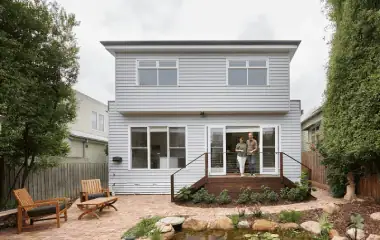Staircase renovations Melbourne
“A flight or series of flights of steps and a supporting framework, casing and balusters connecting separate levels. Also called stairway”

26 April 2016
By KM
We know that building an upper floor extension rather than a ground floor extension avoids excavation costs, removal of trees and allows you to retain your outdoor space. But, in a home that has more than one level, the staircase inevitably becomes an important part of the décor. It is an essential component that connects the established ground floor to the newly created spaces above.
Implementing the staircase may compromise part of the ground floor space but it doesn’t mean you have to compromise on style. A beautifully designed and crafted staircase is often used as a focal point, an accent piece and can even become the hero of the room. Who could forget the iconic grandiose central staircase of the Plantation House in Gone with the Wind! Many early homes and commercial buildings in Melbourne have wonderful examples of wooden staircases that have strong heritage values.

Staircase from movie set ‘Gone with the wind”
Location of the stairs for a second storey extension is one of the first decisions made in any design. Stairs should be comfortable, safe; easy to climb and provide adequate height clearance. There is guidance in the Building Code of Australia Part 3.9.1 and stairs must comply in order to be passed by the building surveyor.
In most cases the staircase is located near the main entrance or living area allowing for better flow of traffic and keeping the privacy of other zoned areas. The staircase should also visually complement and enhance the rest of the home.
There is also an opportunity to provide a cloak room or storage area underneath the staircase.
The extent of remodelling being made to your ground floor will determine how much space will be available as stairs can take up a considerable amount of space. Luckily with the use of 3D modelling software, Supa Group clients can visually see the completed design to scale and modify details so your project is properly thought out for inclusion in the plans and specifications.
There are lots of strategies, shapes and designs of staircases that will suit any home. A modern and contemporary staircase might incorporate stainless steel cable or glass balustrade with open risers whereas a more traditional staircase is usually made of Hardwood timber and turned newel posts and balusters.
We’ve listed some of the most common staircases used when adding a second storey extension.
1. Straight stairs
Exactly as their name suggests, this linear staircase is the easiest to go up and down and are usually the easiest to build. They are popular in modern homes where a minimalist look is required and open risers used. This is an example from a project completed in Glen Iris.

2. L-Shaped Stairs
A straight staircase with a bend in it. The bend is 90 degrees and can include a landing area. If the bend occurs closer to the top of staircase it is referred to as a long L stair.

3. U Shaped Stairs
Sometimes called half turn stairs, this style is basically two parallel flights of straight stairs joined by a landing that requires a 180 turn in the walk line. A variation on the U-shape involves winders or pie shaped stairs that substitute the landing area. This style is popular as it can be easier to fit in an architectural plan.

Another important consideration is the requirement for the treads to be safe, particularly if the stair is made of timber. If the staircase is covered by carpet this will make it slip resistant, but if it is left with a timber finish treads must have a slip resistant finish applied to the nosing as a strip to protect users from falling.
[free_consultation]Contact us today to discuss your staircase renovation and find out how we can help.
[/free_consultation]





.webp)



.webp)








